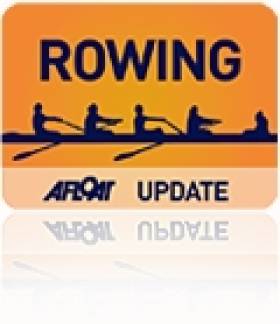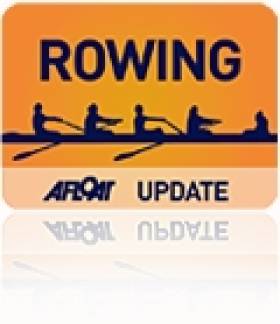Displaying items by tag: SemiFinals
Noel Hendrick Straight Through to European Semi-Final
#Canoeing: Ireland paddler Noel Hendrick qualified for the semi-finals at the European Under-23 Championships today. The K1 competitor went straight through from the first run, taking 13th with a round with no touches at Liptovsky Mikulas in Slovakia. Eoin Teague fell just outside qualification in the same event in the second run.
Thirty of the 61 paddlers made it through to the semis. Hendrick will go off in the final 15 in the semi.
#Rowing: Mark O’Donovan and Shane O’Driscoll produced a remarkable final 500 metres to move from fourth to second in their repechage and qualify for the A/B semi-finals of the men’s pair at the European Rowing Championships in Strathclyde in Scotland.
Three crews qualified from this race, and the Skibbereen men were a second off Austria as the crews entered the final quarter. Serbia and Ukraine held the top two spots. But then O’Driscoll and O’Donovan wound up to stroke rates high in the 40s and swept past Austria and the Ukraine.
European Rowing Championships, Strathclyde, Scotland (Day One, Irish interest)
Men
Pair – Heat Three (First Two to A/B Semi-Finals, rest to Repechage): 1 Belarus 6:37.38, 2 Britain 6:37.76; 4 Ireland (M O’Donovan, S O’Driscoll) 6:48.94. Repechage One (First Three to A/B Semi-Finals; rest to C Final): 1 Serbia 6:33.77, 2 Ireland 6:35.74, 3 Ukraine 6:36.11.
Lightweight Double Sculls – Heat Three (First Two to A/B Semi-Finals; rest to Repechage): 1 Ireland (G O’Donovan, P O’Donovan) 6:27.99, 2 France 6:29.83.
Women
Lightweight Double Sculls – Heat One (Winner to A Final; rest to Repechage): 1 Poland 7:08.54; 4 Ireland (A Casey, D Walsh) 7:22.02.
Fine Finish Sees Ireland Into Second World Rowing A Final
#Rowing: Ireland’s under-23 lightweight quadruple joined the under-23 lightweight pair at the A Final stage of the Under-23 World Championships in Rotterdam. The crew of Fintan McCarthy, Shane O’Connell, Stephen O’Connor and stroke Colm Hennessy finished second to Britain in a fine semi-final. Ireland and Sweden held the qualifying places behind Britain for a good part of the course, but New Zealand mounted an attack in the final third. Ireland upped their rate and held out for second, with Sweden also moving into the A Final.
The under-23 heavyweight quadruple finished fifth in their semi-final. The race was won by Australia, with New Zealand and Britain booking their A Final places by taking second and third. Ireland fought with Ukraine to avoid last and held out at the end to win this battle.
World Rowing Championships, Rotterdam (Irish interest; selected results)
Men
Under-23 Lightweight Pair - Semi-Finals (First Three to A Final; rest to B Final) - Semi-Final One: 1 Greece 6:39.18, 2 Switzerland 6:40.01, 3 China 6:44.52. Semi-Final Two: 1 Ireland (S Mulvaney, D O’Malley) 6:46.20, 2 Turkey 6:49.11, 3 United States 6:50.75.
Under-23 Quadruple - Semi-Finals (First Three to A Final; rest to B Final) - Semi-Final One: 1 Poland 5:51.05, 2 Italy 5:52.38, 3 Germany 5:52.53. Semi-Final Two: 1 Australia 5:54.34, 2 New Zealand 5:56.53, 3 Britain 5:56.93; 5 Ireland (D Buckley, J Casey, P Boomer, S McKeown) 6:12.94.
Under-23 Lightweight Quadruple - Semi-Finals (First Three to A Final; rest to B Final) - Semi-Final One: 1 Italy 6:07.44, 2 Canada 6:09.42, 3 Germany 6:10.05. Semi-Final Two: 1 Britain 6:06.01, 2 Ireland (F McCarthy, S O'Connell, S O'Connor, C Hennessy) 6:07.18, 3 Sweden 6:07.28.
Liam Jegou Excels in Second Run to Claim Semi-Final Place at World Championships
#Canoeing: Liam Jegou qualified for the semi-final of the canoe slalom World Championships in Lee Valley, England today. The France-based teenager produced an impressive, penalty-free, second run in the C1 to place ninth, with 10 places available. In his first run, he incurred penalties on gates eight and 11 and had four seconds in penalties, but would have fallen outside qualification in any case. Jake Cochrane placed 68th and 64th in his two runs.
Canoe Slalom World Championships, Lee Valley, London, Day Two (Irish interest)
Men
C1 – First Run (top 20 to semi-finals): 37 L Jegou 95.98 seconds (incl 4 sec pen); J Cochrane 161.15 (incl 54 sec pen). Second Run (10 qualify): 9 Jegou 90.83; 64 Cochrane 108.38 (incl 8 sec pen).
Women
C1 – First Run (top 15 to semi-finals) 32 C O’Ferrall 191.62; Second Run: O’Ferrall 132.14 (incl 4 sec pen)
#ROWING: Ireland’s men’s four reached tomorrow’s semi-finals of the World Under-23 Rowing Championships by finishing third in their repechage today. Belarus and Serbia finished first and second, with Ireland showing their determination to stay in the Championships by taking the final qualification spot. Russia, who are a bigger crew than the Irish, lost out by finishing fourth.
World Under-23 Rowing Championships, Varese, Italy, Day Two (Irish interest; selected results)
Men,
Four – Repechage (First Three to A/B Semi-Finals): 1 Belarus 6:18.7, 2 Serbia 6:24.33, 3 Ireland (R Bennett, K Neville, F McQuillan-Tolan, R O’Callaghan) 6:28.54, 4 Russia 6:31.41.
Lightweight Double Sculls – Heat Three (First Two Directly to A/B Semi-Finals; Rest to Repechage): 1 France (P Houin, D Debourdeau) 6:34.72, 2 Italy (F Gherzi, N Forcellini) 6:37.86;
3 Ireland (S O’Driscoll, G O’Donovan) 6:38.34, 4 Serbia 6:54.08, 5 Poland 7:04.23,
Women,
Lightweight Single Sculls – Heat Three (First Two Directly to A/B Semi-Finals; Rest to Repechage): 1 Cyprus 8:04.62, 2 France 8:06.67; 3 Britain 8:13.89, 4 Ireland (D Walsh) 8:22.48, 5 Russia 8:26.00.
Dilleen and Puspure Seize Place in World Rowing Semi-Final
The repechage was won by Sarah Trowbridge and Kathleen Bertko of the United States, and Ireland battled with Switzerland before taking control of the second qualification place. But Denmark pushed Dilleen and Puspure hard over the last three hundred metres, only to find the Ireland athletes refusing to yield.
World Rowing Championships, Bled, Slovenia – Day Three (Irish interest)
Women
Double Scull – Repechage One (First Two to A/B Semi-Finals; rest to C/D Semi-Finals): 1 United States (S Trowbridge, K Bertko) 6:58.68, 2 Ireland (L Dilleen, S Puspure) 7:01.04; 3 Denmark 7:01.86, 4 Switzerland 7:07.41, 5 Greece 7:12.66, 6 Lithuania 7:16.31.
Lightweight Single Scull – Repechage Two (First Two to A/B Semi-Finals; rest to C/D Semi-Finals): 1 Hungary (Z Hajdu) 7:59.26, 2 Algeria (A Rouba) 8:02.40; 3 Ireland (S Dolan) 8:06.35, 4 Thailand 8:08.52, 5 Portugal 8:10.73, 6 El Salvador 8:17.08.
































































